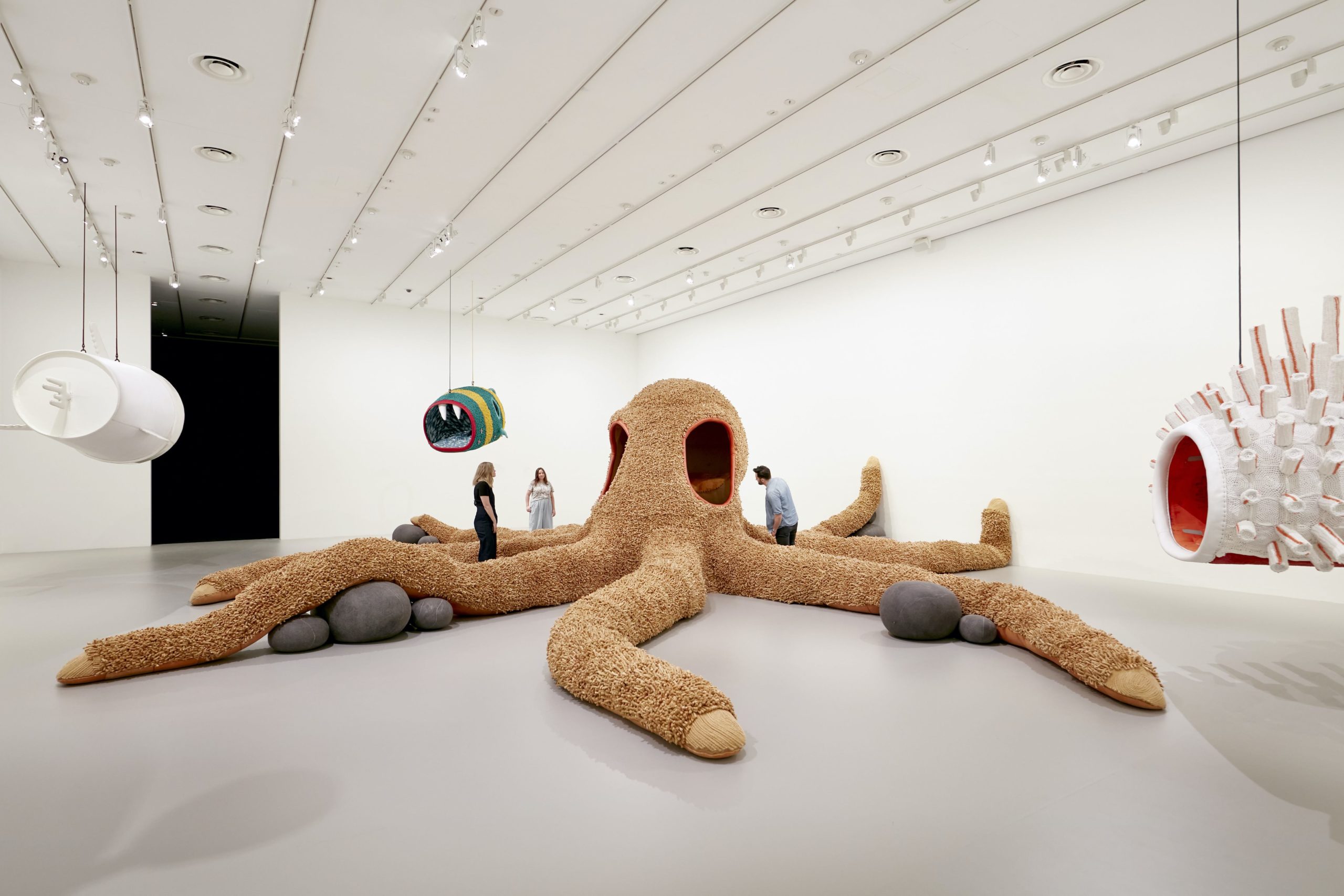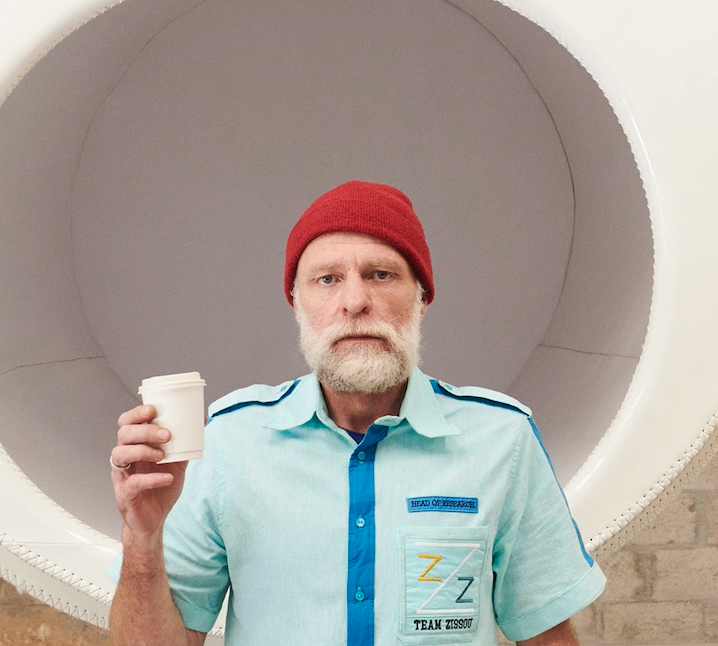South African designer Porky Hefer expands and captures the imagination through his work. His oversized, interactive furniture in PLASTOCENE is both whimsical and daunting as you dive deep into the vision behind each piece and the tons of waste used to create them. This breadth of work, representing mutant sea creatures, is a cautionary tale about what the future of planetary life will look like if we do not change our habits. The collection features Buttpuss, part cigarette, part octopus; Q-Tip, part cotton swab, part hammerhead shark; a Suckerfish of “straws”; Flat White, part coffee cup, part sad face reminiscent of a filter feeder such as a whale; and Sabre Toothed Netfeesh, part fish, part yellow and green marine rope representing BP, the oil/gas company responsible for the largest oil spill in history. —Annabel Schulz
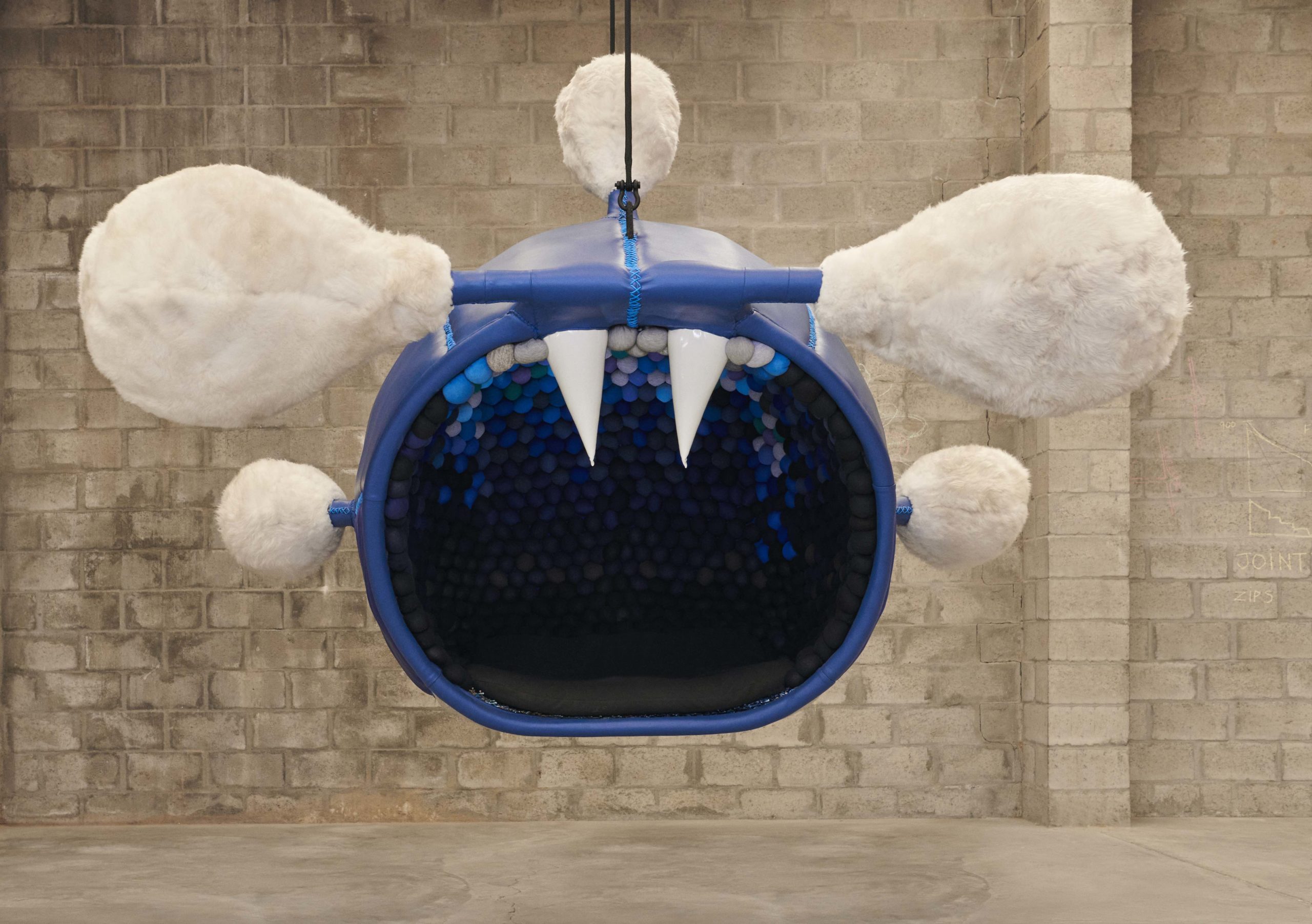
Q-tip designed 2019, manufactured 2020; recycled advertising banner, leather, offcut upholstery fabric, sheepskin, salvaged T-shirt cotton, recycled polyester stuffing, salvaged hand-tufted silk carpet, foam, steel; 300.0 x 220.0 x 174.0 cm; Frame manufacturer: Streetwires; Textile production: Mielie; Sewer & pattern maker: M Clothing; Assembly: Wolf & Maiden Creative Studio; Upholstery: Leon at CXIXX; Commissioned by the National Gallery of Victoria, Melbourne; Purchased with funds donated by Barry Janes and Paul Cross, Neville and Diana Bertalli, 2020; © Porky Hefer; Image courtesy of Porky Hefer and Southern Guild
Much of your work tackles the question of what it means to be human. How would you personally answer that question?
I think my work definitely proves what a human, with the help of other humans, is capable of doing. It is all handmade and you can immediately see the labour of love that went into making it. The intention is that it helps preserve the traditions and the techniques the work employs. Most of my work is a commentary on nature and humans’ impact on it. But I think I am more interested in being animal than human. When I started my first company, Animal Farm, it was about doing work that was far more instinctual than rational. To not consider social norms when deciding whether I should do something or not. To trust my gut and just do it. To not think about who would buy it for how much, but whether it is worth doing for my own evolution. I now make giant bird’s nests for humans, polar bear daybeds, orangutan sofas and octopus DJ booths.
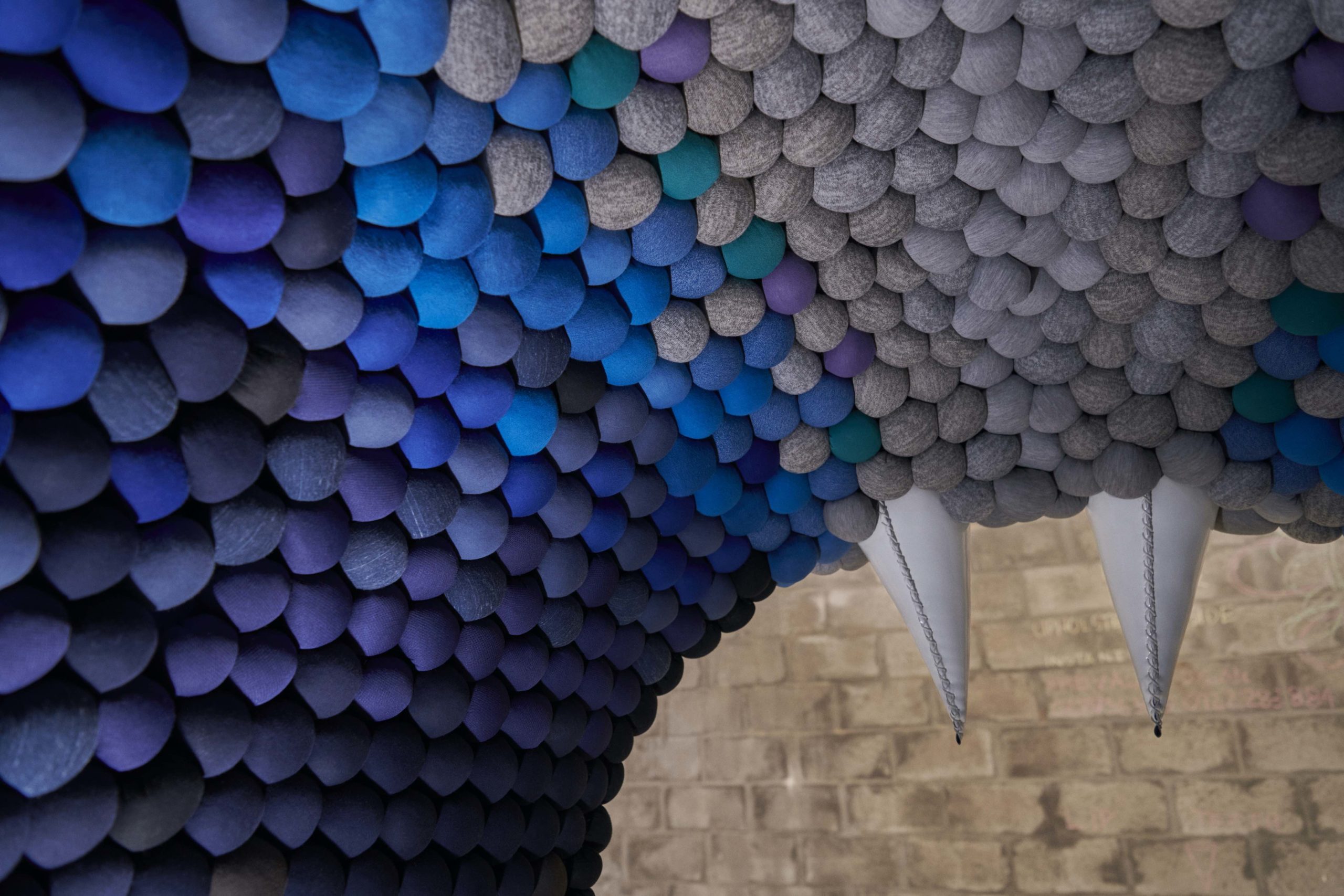
Q-Tip interior; © Porky Hefer; Image courtesy of Porky Hefer and Southern Guild
Your latest exhibit focuses on the impact of ocean pollutants. What inspired you to create this work?
When I was at Basel [Design Miami/Basel] showing the Endangered series with Southern Guild and SFA Advisory for the Leonardo DiCaprio Foundation, I picked up a copy of the National Geographic “Plastic or Planet?” issue. The cover grabbed me; the article and data shocked me; and the images haunted me. After that, I could just see plastic trash everywhere including in my own home and habits. We use far too many plastics and recycle far too few. Education is a good place to start to try to get people to realise that they are part of the problem.
When the NGV (National Gallery of Victoria) brief came in, I realised it was a great opportunity and platform to amplify the warning signs all around us. Most of my previous work has been about mimicry and about imitating what is already out in nature. For this project, rather than show what was under threat, I imagined what things would look like if we didn’t change our habits and behaviour. It was a lot more difficult inventing creatures as there are no real boundaries, especially in my imagination. For the idea to have traction, I wanted to create more than just five objects, so to give them context, I came up with the idea of PLASTOCENE.
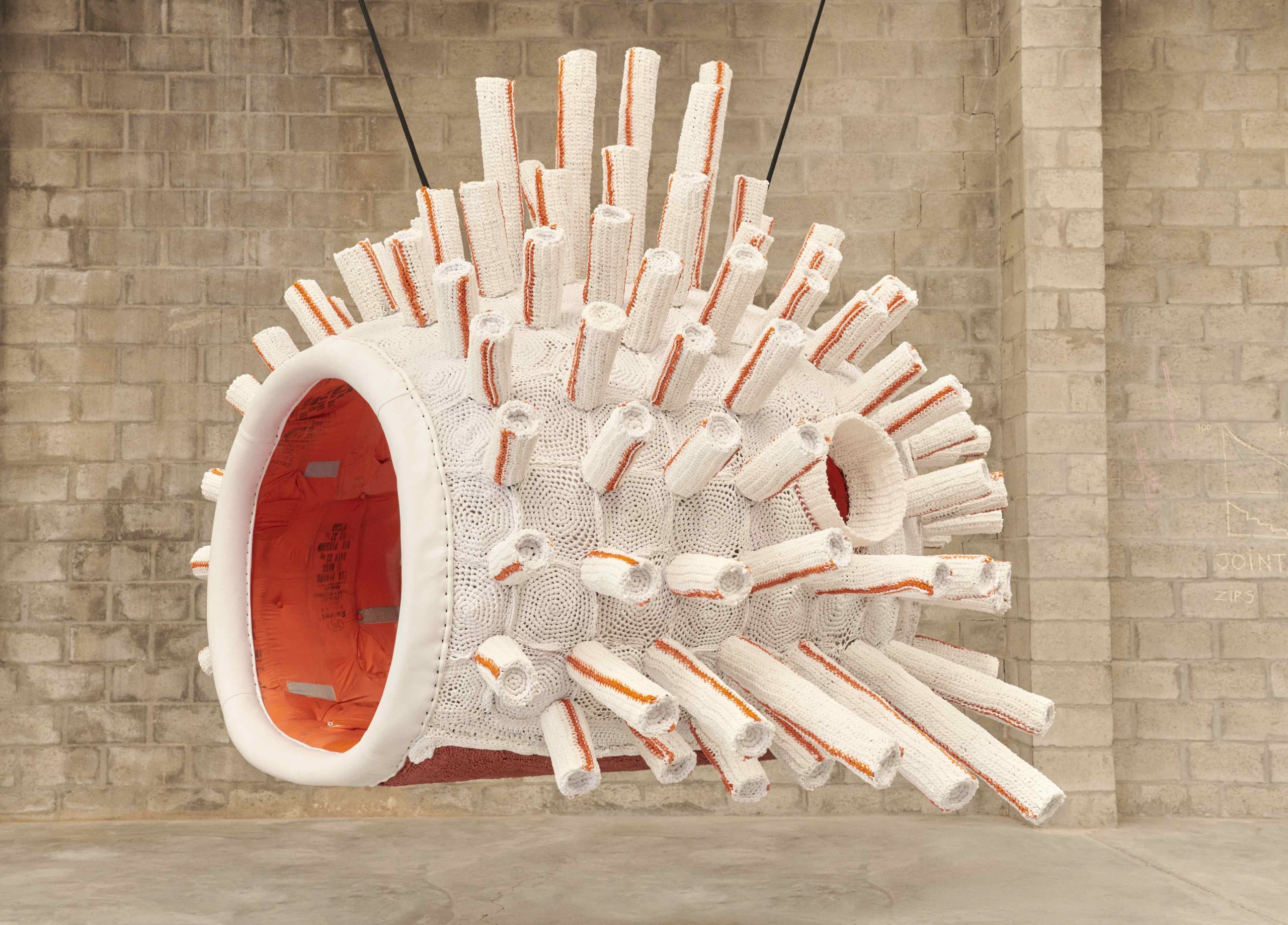
Suckerfish designed 2019, manufactured 2020; masonry twine, resin, PVC pipe, recycled T-shirt yarn, salvaged life jackets, leather, steel; 252.0 x 290.0 x 200.0 cm; Frame manufacturer: Streetwires; Crochet and quilting: Mielie; Upholstery: Leon at CXIXX; Commissioned by the National Gallery of Victoria, Melbourne; Purchased with funds donated by Barry Janes and Paul Cross, Neville and Diana Bertalli, 2020; © Porky Hefer; Image courtesy of Porky Hefer and Southern Guild
Can you describe the shift from the ANTHROPOCENE to the PLASTOCENE?
The first conceptualisation of the ANTHROPOCENE era was “scientific thought as a geological force,” yet it could be argued that our self-referential epoch will instead be defined by our ignorance and the destructive capacity of our species. A reliance on fossil fuels and a never-ending hunger for convenience and hyper-efficiency, at whatever cost, has led to a period of rapid ecological decline. Ecosystems around the globe are destabilising in what may ultimately be defined as a period of mass extinction.
Our plastics are filling the oceans and heavy pollutants are changing the pH of our seas. While thousands of species die off, unable to adapt to the rapid changes in their environments, others begin to transmute. Here, we see the earliest indications of the PLASTOCENE, a new era defined by organismal adaptation to the endless abundance of plastics and pollutants accumulating in our environment. In a twist of evolutionary fate akin to the genesis of the mitochondria, refined hydrocarbon distillates fuse with DNA to generate a new type of life—transitional forms that exemplify the fruits of the fossil-fuel consuming era before them. The future painted here is one that humans would struggle to inhabit, but at best, we can hope that life continues in this new form, following the mass extinction that we so selfishly perpetuated.
The various creatures mash-up with some of the biggest pollutants in our oceans—cigarette butts, drinking straws, q-tips or earbuds, fish nets and single-use plastic takeaway paraphernalia. Q-Tip, for instance, is part-earbud, part-hammerhead shark, part-black moor.
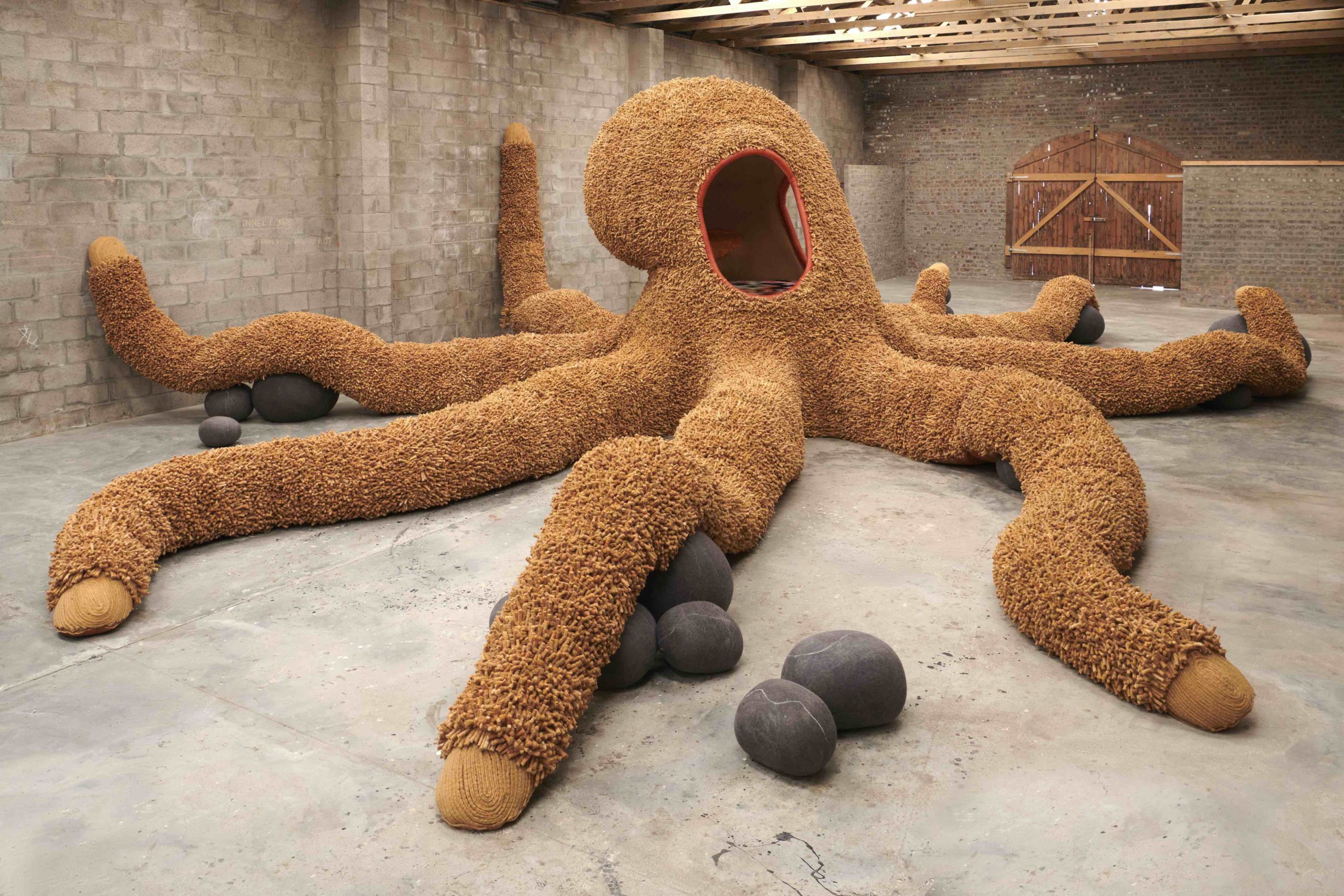
Buttpus designed 2019, manufactured 2020; felted karakul wool, industrial felt, canvas, leather, sheepskin, salvaged hand-tufted wool carpet, recycled PEP stuffing, foam, steel; 1512.0 x 1512.0 x 328.0 cm; Frame manufacturer: Streetwires; Felting: Ronel Jordaan Textiles; Sewer & pattern maker: M Clothing; Assembly: Wolf & Maiden Creative Studio; Karakul wool sponsored by Jonay Wool Carding; Commissioned by the National Gallery of Victoria, Melbourne; Purchased with funds donated by Barry Janes and Paul Cross, Neville and Diana Bertalli, 2020; © Porky Hefer; Image courtesy of Porky Hefer and Southern Guild
How did you source materials?
I am surrounded by incredibly talented artisans and craftspeople all over Cape Town who can create wonders with their hands using the local resources around them. They are what really bring the magic to the pieces. Buttpuss is clad with around a ton and a half of karakul wool “cigarette butts” that were hand-rolled by Ronel Jordaan and her team. All the dyes used to create the incredible colour were 100% natural and organic, with slight inconsistencies making a far more organic surface. The floor covering was sourced from a local carpet store, Mae’s Rugs, from a shipment of silk carpets that got water-damaged on the journey and were unsaleable. There is one in Q-Tip as well. The interior of Q-Tip is covered in pom poms expertly made from offcut T-shirt material by Adri Schultz and her team at Mielie. Most of the materials on the outside are recycled tents and the ends of rolls I found in an upholsterer’s storage.
Netfeesh is woven with offcuts of rope I got from a rope manufacturer. The beginning and end parts of the rope are not the right tension, so were discarded and sold as scrap. The colours changed continuously, so I had to adapt the design often. The teeth are just plastic bags and waste from the studio that I melted and covered with an old drop sheet. I came across a number of rejected squeaky dog balls and decided to put them in the cushion of Netfeesh, so that when you climb in, the balls make sounds of a sad dolphin. The tail is a pool noodle my friend had at her house and no longer had use for.
The body of Suckerfish is crocheted by Adri f Schultz and her team at Mielie from waste T-shirt material and the straws from offcuts of rope used to make fishing nets. I came across a warehouse stacked high with decommissioned lifejackets from sight-seeing boats in Hout Bay Harbour. We deconstructed and joined them together to create a massive quilt, which we used to cover the inside.
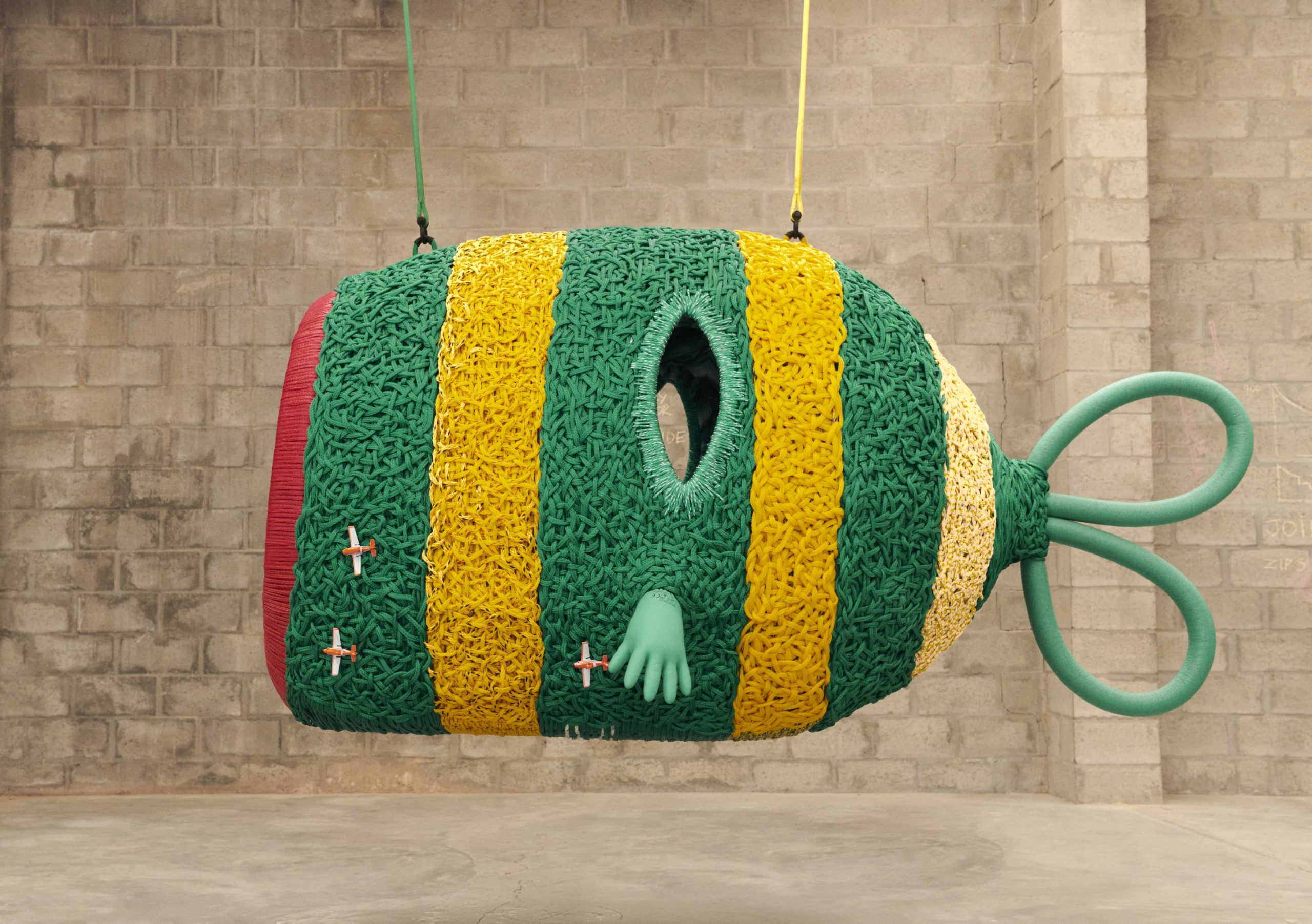
Sabre toothed netfeesh, 2020; 10mm basketweave rope, pool noodle, rubber gloves, plastic toy aeroplanes, dog toys, digitally printed polyester fabric, foam, steel; 245.0 x 190.0 x 135.0 cm; National Gallery of Victoria, Melbourne; Purchased with funds donated by Barry Janes and Paul Cross, Neville and Diana Bertalli, 2020; © Porky Hefer; Image courtesy of Porky Hefer and Southern Guild
What do you hope viewers of the PLASTOCENE will take away from the show?
I want people to realise that they, too, are part of the problem. The little things they do every day, the disposable items they use so often, the high cost of convenience. We need to challenge the current system, our habits and routines.
COVID-19 has reshaped many of the ways we consume. What are your hopes for the future?
I think one of the positives is that people have started to buy local and support local economies. A move away from big chain stores and towards more boutique and craft offerings. We need to reconsider all the supply chains and make them much shorter and much more local. This will, of course, encourage more local suppliers and businesses. I think the pandemic has made people rethink and try different things. And please, less plastic and less packaging.
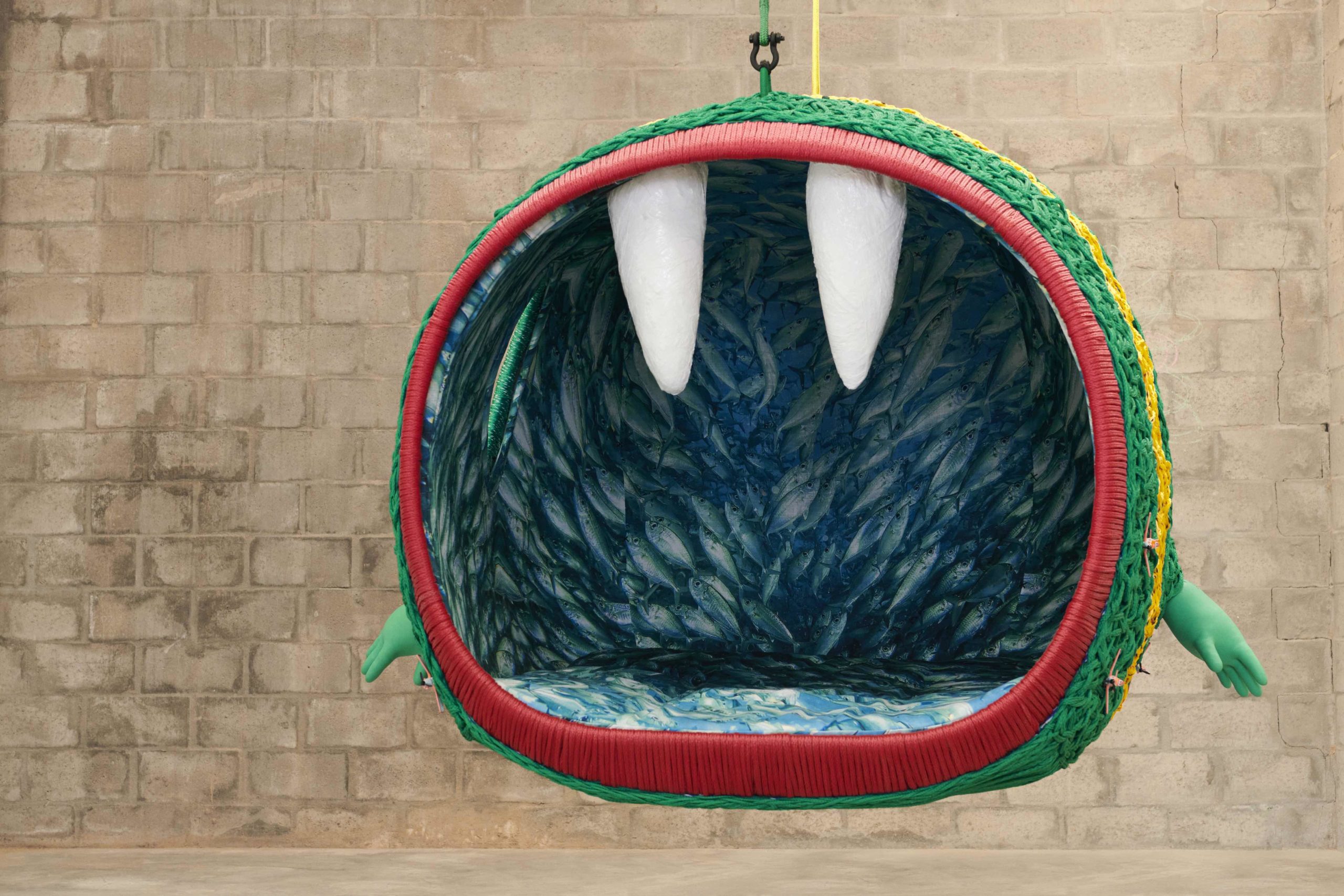
Sabre toothed netfeesh interior view; © Porky Hefer; Image courtesy of Porky Hefer and Southern Guild
What is one piece of advice you’d give to aspiring artists?
Don’t make to sell.
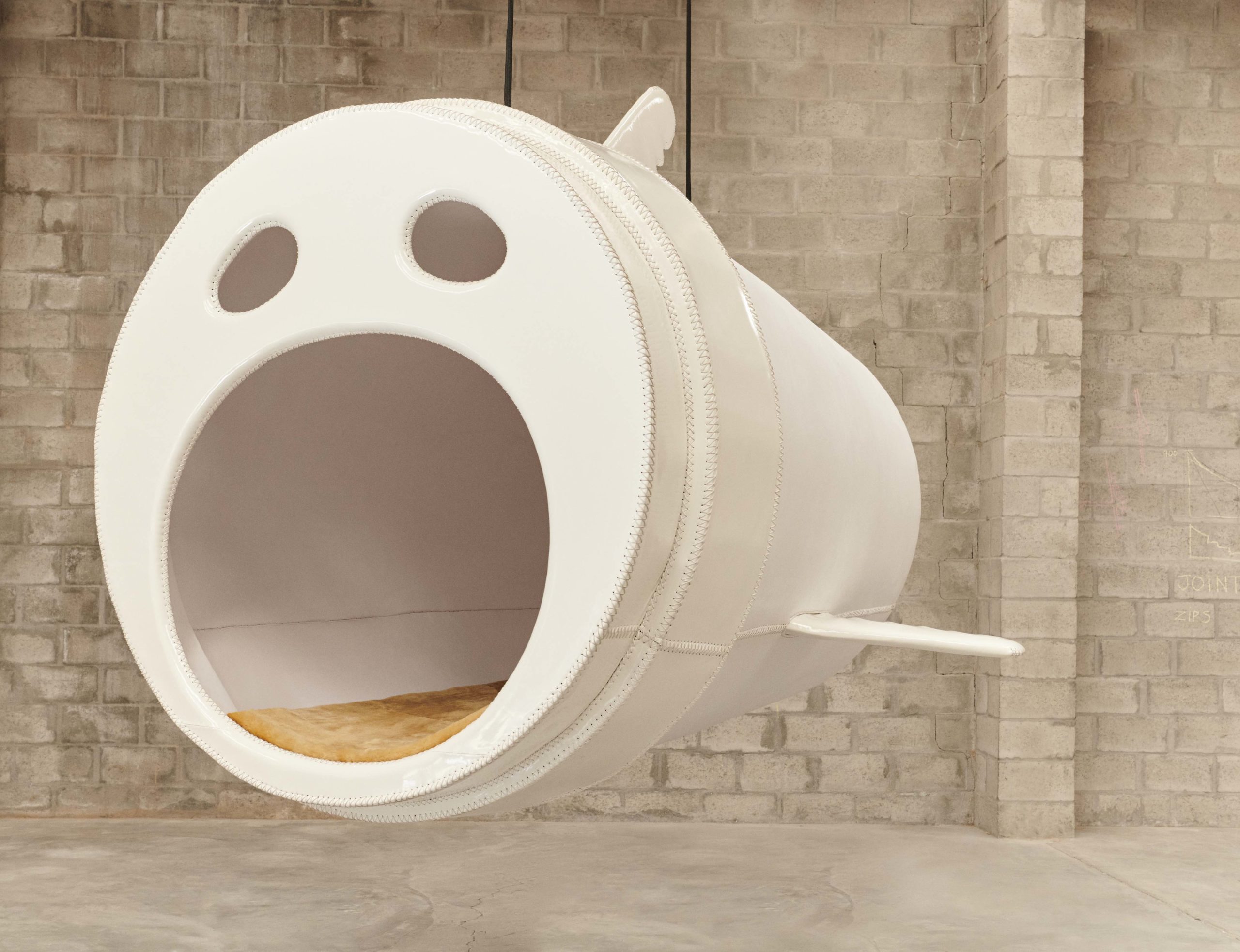
Flat white designed 2019, manufactured 2020; leather, faux leather, sheepskin, plywood, foam, steel; 265.0 x 215.0 x 196.0 cm; Frame manufacturer: Streetwires; Assembly and upholstery: Wolf & Maiden Creative Studio; Commissioned by the National Gallery of Victoria, Melbourne; Purchased with funds donated by Barry Janes and Paul Cross, Neville and Diana Bertalli, 2020; © Porky Hefer; Image courtesy of Porky Hefer and Southern Guild
How has the COVID-19 pandemic changed the art world?
I think it’s a lot harder to get your work out there. Instagram and virtual exhibitions are fine for some kinds of art and they are selling well. But for me, it’s very important that people see it in person, and have the opportunity to come up close and look at the details, to see the scale of the pieces and, of course, interact with them. My pieces are made to be climbed in, to be experienced. I am lucky that the NGV Triennial is happening as it means people get to meet these incredible creatures we have created.
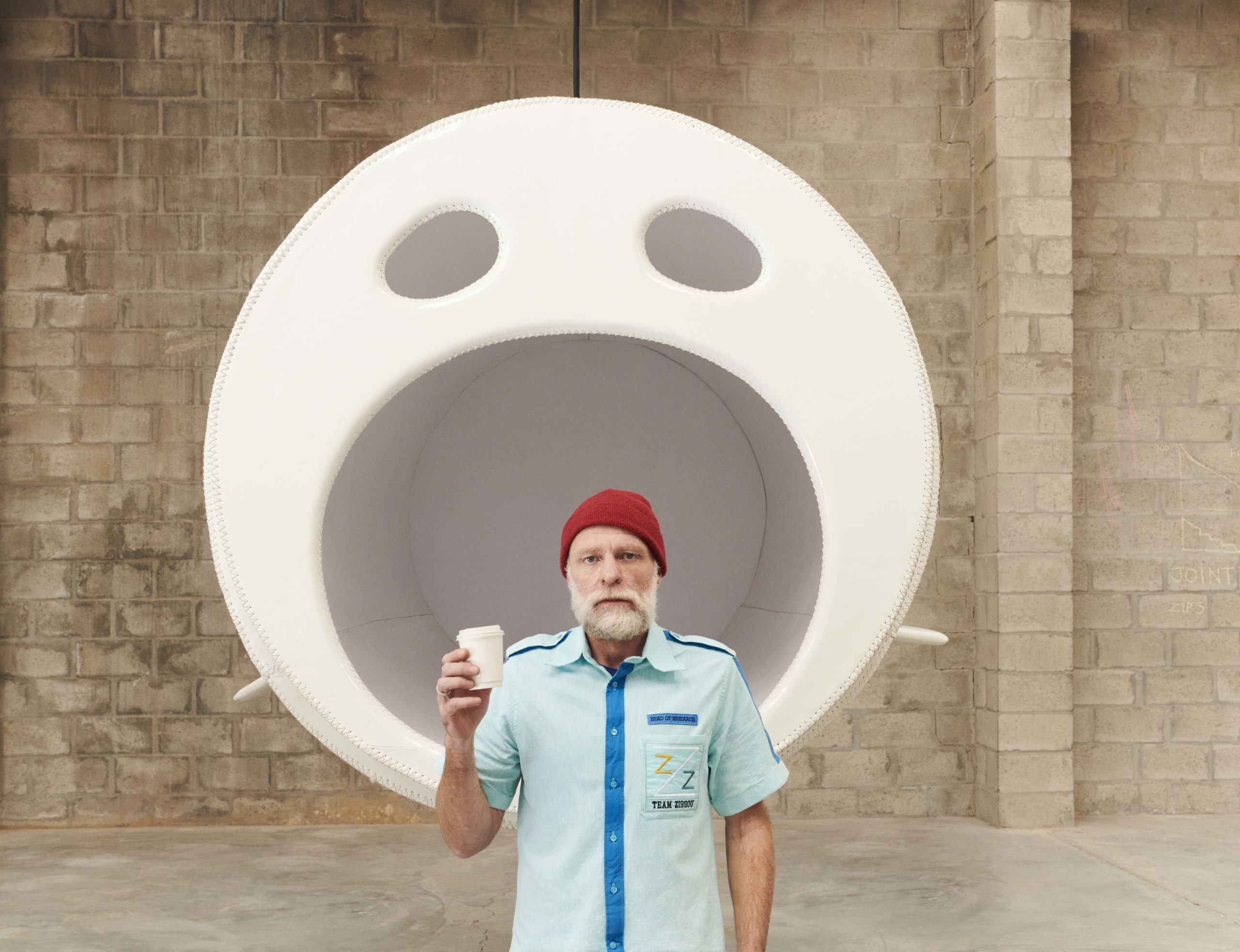
Porky Hefer with Flat white; © Porky Hefer; Image courtesy of Porky Hefer and Southern Guild

